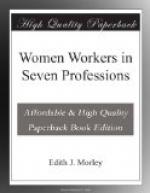The training for kindergarten and lower-form mistresses is less expensive, arduous, and lengthy. Students are required to give evidence of having received a good secondary education; they can then take their First Froebel Certificate after one year, and their Higher Froebel Certificate after about two years’ training. The cost of such training varies from L30 to L58 non-resident; L120 to L150 resident. If they elect to go to the House of Education at Ambleside, the training is for two years, and is specially suited to those who wish to teach in private families. The cost amounts to L90 a year, including residence, which is obligatory.
Kindergarten assistant-mistresses usually obtain from L90 to L100 salary for part-day work, while for whole-day work the rate is the same as that of their colleagues. Mistresses in charge of a large kindergarten department often receive additions to their stipend if they are willing to train student-mistresses for Froebel examinations.
The Ambleside students usually teach small private classes, or accept posts as resident governesses in families. Their remuneration varies in accordance with the work done, but it is usually about the same as that received by kindergarten and lower-form mistresses.
The stipends of other secondary teachers are considered in the article by Dr O’Brien Harris (see p. 32). It should be noted that in good private schools where the standard of teaching is equally high, the salaries are approximately on the same scale as in public schools. But private schools vary enormously in standing. When they are inferior, the teachers are paid miserable pittances, and are often worth no more than they receive. Such schools, however, are rapidly decreasing in number, since they cannot survive competition with public State-aided schools. The best private schools, on the other hand, supply a real need, and, as a large proportion of their pupils do not enter for public examinations, it is possible in them, to make valuable experiments which could not easily be tried in larger subsidised institutions.
In boarding-schools, the conditions do not markedly differ from those obtaining in day-schools. The chief danger is lest the teachers should suffer from the strain of supervision-duties in addition to their work in school. But in the better schools this is avoided by the appointment of house-mistresses, the teaching staff living apart from the girls, either in lodgings or in a hostel of their own. When they “live in,” the value of their board for the school terms is usually reckoned at about L40 a year, which is deducted from the ordinary salary of an assistant. The cost of living in a mistresses’ house is usually higher, but there are many counterbalancing advantages, the chief of which is complete freedom when school duties are over.




